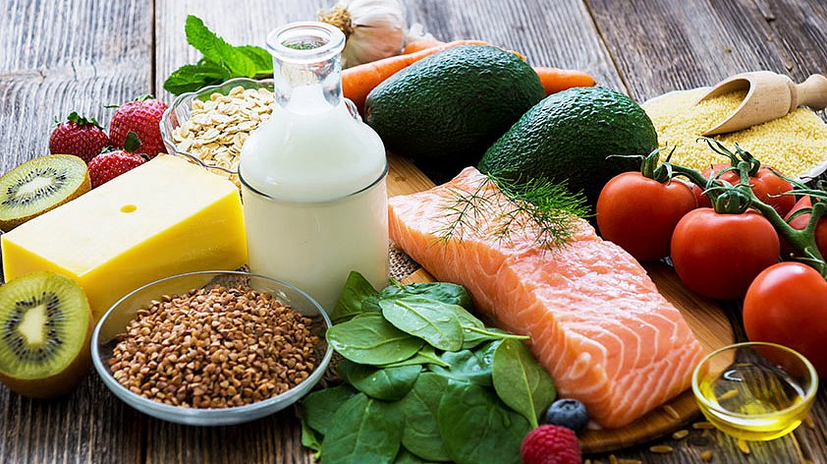
Diabetes mellitus (DM) is a group of diseases associated with impaired glucose absorption. As a result, its concentration in the blood increases significantly.
Diabetes mellitus develops for various reasons. Some types of the disease are caused by genetic predisposition, while others are related to lifestyle or environmental factors.
This disease causes great harm to the body. Prolonged excess of glucose (sugar) in the blood gradually destroys the walls of blood vessels and can cause kidney, heart dysfunction and death of nerve cells. ButSuch complications can be prevented. The main thing is to follow the doctor's recommendations for treatment and adjust your diet.
types of diabetes
Depending on the mechanism of formation of pathology, there are two main types of diabetes mellitus: the first and the second.
Apart from this, there are other types of diabetes:
- Prediabetes: A condition in which blood sugar is at the upper limit of normal, but not higher;
- Insipidus is a disease in which the body lacks antidiuretic hormone (ADH) or the kidneys lose sensitivity to it. As a result, symptoms similar to diabetes occur - thirst, frequent urination, weakness;
- Gestation is a temporary condition that develops during pregnancy and is characterized by elevated blood sugar levels;
- Latent diabetes mellitus, which develops asymptomatically for a long time (similar to type 2 diabetes), but at the same time, according to the development mechanism, it is close to type 1 diabetes (malfunction of the immune system);
- A labile form of diabetes mellitus, in which even continuous treatment with insulin does not eliminate causeless increases in blood sugar;
- A kidney disease in which the kidneys stop filtering fluid. As a result, symptoms similar to diabetes occur: frequent urge to urinate and an intense feeling of thirst;
- Postoperative conditions that develop after pancreas surgery;
- Pancreatic disease, which occurs against the background of chronic pathology of the pancreas (for example, chronic pancreatitis);
- Extrapancreatic disease, which occurs against the background of chronic pathology, but can gradually lead to disruption of the pancreas.
diabetes mellitus type 1

In this type of disease, the body's own immunity destroys the pancreas cells that are responsible for producing insulin. As a result, insulin does not enter the blood and does not deliver glucose to the cells. Because of this itRemains inside and slowly destroys them.
Type 1 diabetes often develops in children and teenagers, although it can occur at any age.
Symptoms of type 1 diabetes usually appear acutely.
Symptoms of Type 1 Diabetes:
- intense thirst and hunger,
- weakness,
- frequent urination,
- sudden weight loss,
- blurry vision.
Without treatment, these symptoms are accompanied by symptoms of diabetic ketoacidosis (one of the complications of diabetes): thirst, weakness, lethargy, nausea, vomiting, stomach pain, difficulty concentrating. The person may even fall into a coma. .
People with type 1 diabetes take insulin throughout their lives.
diabetes mellitus type 2

In this case, the pancreas produces enough insulin, but the cells are insensitive to it, so they cannot absorb glucose and its concentration in the blood increases.
Excess weight is a major risk factor for developing type 2 diabetes.
Type 2 diabetes mellitus can develop unnoticed for a long time, so people do not always notice the first symptoms of the disease.
Possible symptoms of type 2 diabetes:
- frequent urination;
- strong thirst;
- Feeling hungry even after eating;
- Tiredness;
- blurred vision;
- wounds that heal slowly;
- Darkening of skin on elbows and knees;
- Tingling, pain, or numbness in hands and feet.
risk of developing diabetes
Types of diet for diabetes
There is no special diet for diabetes mellitus, but people with this diagnosis are often mistakenly advised to choose one of the strict nutrition systems that will allegedly help overcome the disease. For example, diet fromEliminate carbohydrates altogether, replace them with proteins, eat only buckwheat porridge, or follow another mono-diet.
no carbohydrate diet
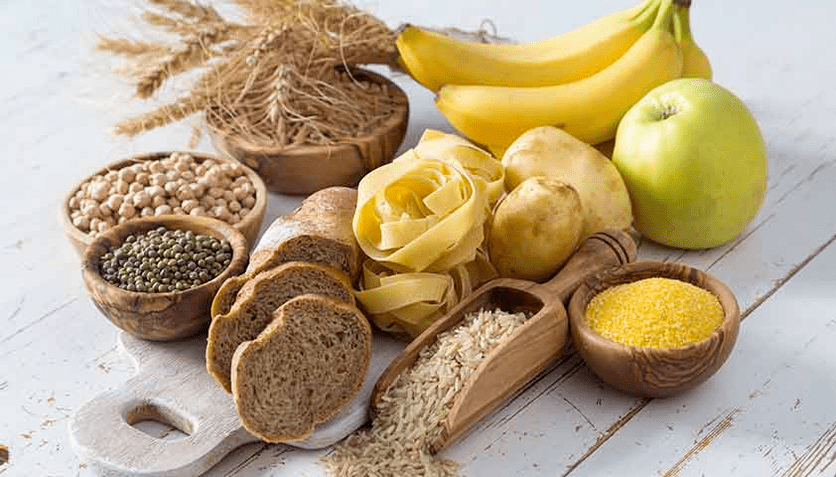
Carbohydrates are the main source of energy for cells. They come in three types: sugar, starch, and fiber. Sugars are simple carbohydrates, including glucose. Natural sugars are found in fruits and vegetables, artificial (added) sugars are found in confectionery. Found in products, sauces and canned food. Starch and fiber are complex carbohydrates. Starch is found in fruits, seeds and tubers of plants, fiber - in fruits and vegetables, whole grain breads and pasta.
Glucose is a carbohydrate that provokes the main disorders in diabetes mellitus. Because of this, proponents of a no-carbohydrate diet believe that eliminating glucose from the diet, as well as all carbohydrates, will help prevent the disease. This is false. .
A healthy ratio of carbohydrates in the diet is 50/55%
Carbohydrates are a source of energy, so you should not completely exclude them from your diet, and moreover, it is quite difficult, because they are found in almost all foods.
In the absence of carbohydrates, the body begins to obtain energy from fats and proteins, the proportion of which, when following such a diet, usually increases due to the consumption of red meat. And this is a risk factor for heart disease and colorectal cancer. Is a risk factor.
In addition, carbohydrate sources such as fruits and vegetables and legumes contain many nutrients and minerals, the deficiency of which has negative effects on health and can worsen diabetes.
high protein diet
A protein, or high-protein, diet is a diet in which the daily protein intake exceeds the standard (0. 8 g per 1 kg of body weight) and exceeds 15-16% of total calorie intake.
There is no consensus on whether people with diabetes need to eat more protein. However, excess protein increases some health risks.
An excess of protein in the diet increases the load on the kidneys and stones can begin to form in them. In addition, protein is mainly found in meat and dairy products, so when following such a diet, due to the fact that vitaminsAnd mineral deficiencies are more likely to occur when fruits and vegetables are excluded from the diet.
buckwheat diet
Buckwheat diet is a mono-product diet with strict restrictions. Such a diet consists of 70% cereals, to which other low-fat foods are gradually added: vegetables, dried fruits, white meat, fish.
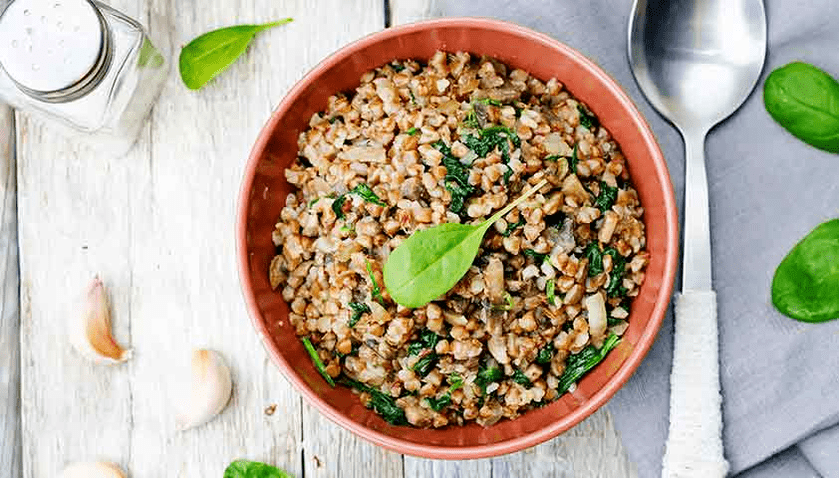
Buckwheat Cereals for diet are prepared in a special way: they are not boiled, but poured with boiling water and left for 4-6 hours.
The main disadvantage of such a diet is the limited range of foods consumed. Due to this, the person may suffer from a deficiency of beneficial vitamins and minerals. In addition, the buckwheat diet is psychologically difficult to follow: it may seemThat is, nothing is possible. Therefore the risk of slipping and eating high calorie foods increases significantly.
diet for type 1 diabetes
There is no special diet for people with type 1 diabetes, but it is important for people with this diagnosis to calculate the amount of carbohydrates they eat daily and take into account the glycemic index of foods. In addition, theyThe principle or method of a healthy plate should be followed.
The amount of carbohydrates in the diet of a person with type 1 diabetes should not exceed an average of 17 bread units per day.
The amount of carbohydrates that a person with diabetes can normally tolerate varies from person to person and depends on weight, physical activity level, daily calorie needs, and how the body metabolizes carbohydrates.
You can calculate the amount of carbohydrates you need per day from a nutritionist or your doctor. After converting the carbohydrates you eat into bread units, your doctor will help you determine the amount of insulin needed to absorb glucose. Will do. Over time, the person will learn to calculate it himself.
Table of correspondence of carbohydrate-containing products with bread units
| product | 1 XE (about 15 grams of carbohydrates) |
white bread |
1 piece |
Borodino Bread |
1 piece |
Cereal |
1 tbsp (dry) |
Oatmeal |
1 tbsp (dry) |
| Potato | 1 medium tuber |
| orange | 1 piece |
| strawberry | 10 pieces |
| Apple | 1 piece |
| Milk | 1 glass |
milk ice cream |
⅔ serving (without glass) |
glycemic index
The glycemic index (GI) is a number that shows how the foods you eat affect your blood sugar levels.
The glycemic index is not calculated independently; It is usually indicated on food packaging.
It is believed that low GI foods raise blood sugar levels slightly and break down more slowly, so you stay full longer. Higher GI foods are digested faster and lower blood sugar levels. also increases significantly.
All carbohydrate-containing products are divided into three groups:
- Low GI (from 55) skimmed milk, apples, peanuts;
- With average GI (from 56 to 69) – spaghetti, buckwheat, ice cream;
- With high GI (70 and more) – white bread, rice milk, white rice.
It is useful for a person suffering from diabetes to know the glycemic index of a food. This way he will be able to include low GI foods in his diet and will not allow spikes in blood sugar. However, other factors should also be taken into account. should go.
Research shows that the amount of carbohydrates eaten rather than their index has a greater impact on blood sugar levels. Simply put, you can eat apples even to the point of hyperglycemia. Therefore, for most people with diabetes, For example, the best tool for monitoring blood sugar levels is carbohydrate counting.
healthy plate method
The Healthy Plate Method divides foods into five main groups: fruits and vegetables, slow-release carbohydrates, dairy, proteins, and fats. You can combine these groups using a regular plate.
The amount of fruits and vegetables should be a third or half of it. Slow carbohydrates - a third or a little more. The remaining part is occupied by dairy products, a slightly larger part by protein foods and a smaller part by fats.
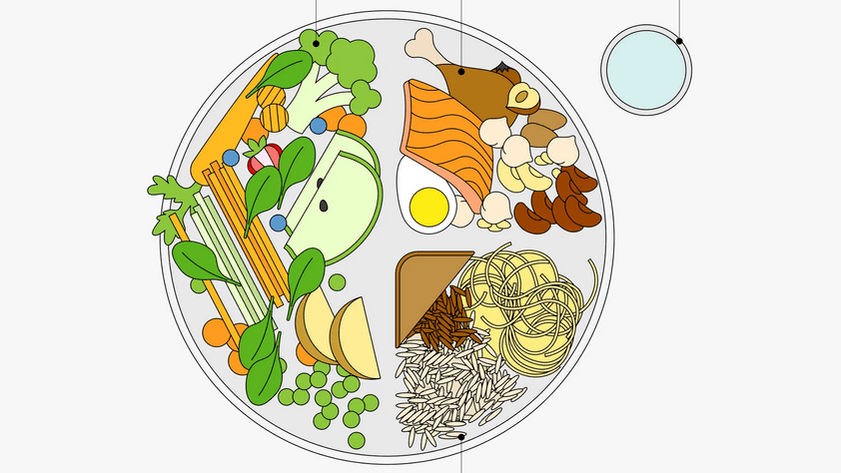
Healthy Plate Method Eating Principles
How to assemble a healthy plate:
- step 1.We select a plate. Its diameter should be equal to the length of the palm.
- step 2.Keep vegetables and fruits in a plate. They can be in any form: fresh, stewed, boiled, canned. A serving should take up half the plate or a little less.
- step 3.Divide the remaining portion of the plate in half. We put slow carbohydrates in the first half - grain products, jacket potatoes, whole grain bread or pasta. We fill the remaining quarter with sources of protein - lentils, beans, peas, fish, eggs, lean meat.
In addition, people with type 1 diabetes should follow important healthy eating principles:
- Drink according to thirst;
- Eat less salt – no more than one teaspoon (5-6 grams) per day;
- Limit consumption of trans fats (found in many prepared and processed foods – fast foods, cakes and pastries);
- Reduce your intake of saturated fats (found in sweet pastries, fatty meats, sausages, butter and lard).
Anyone with type 1 diabetes should discuss their diet with a dietitian to determine the best nutrition and exercise plan for insulin use.
diet for type 2 diabetes
Since carbohydrate-rich foods directly affect blood sugar levels, a carbohydrate-balanced diet is one of the main directions in the prevention of type 2 diabetes.
In order not to count the amount of carbohydrates eaten, doctors recommend that people with type 2 diabetes eat according to the principle of a healthy plate (as is the case with type 1 diabetes). The diet should include non-starchy vegetables, fiberAnd emphasis has been laid on increasing the proportion of lean protein.
Additionally, it is rich in dietary fiber, consumption of which helps avoid spikes in blood sugar and promotes weight loss.
Fiber is digested more slowly, which means it ensures a feeling of satiety for a longer period of time.
When eating with the healthy plate method, at each meal you should mentally divide the plate into three parts. Half should be filled with non-starchy vegetables - fresh or cooked. This could be lettuce, cauliflower, green beans, Could be tomato.
One quarter of the plate should be filled with low-fat sources of protein: cooked fish, boiled meat, legumes, tofu. The portion of protein in the plate should fit in the palm of your hand.
The remaining quarter is complex carbohydrates like whole grain breads and cereals. Their portion should be about the size of a fist.
Additionally, you can add a portion of healthy fat (for example, a few slices of avocado) or sprinkle the salad with a teaspoon of unrefined olive oil.
diet for gestational diabetes
Foods directly affect blood sugar levels, so a healthy, balanced diet helps manage gestational diabetes and pregnancy.
There is no single correct diet that is best for women with gestational diabetes. The issue is that what works for one person may not work for another. But there are several general diets that can help control the disease. Let's help.
DASH Diet (Dietary Approaches to Stop High Blood Pressure)
DASH, or Diet to Control High Blood Pressure, was developed for people with high blood pressure. Over time, doctors and scientists discovered that such a diet helps other diseases, including gestational diabetes.
Thus, a study of 52 women with gestational diabetes found that following the DASH diet for 4 weeks reduced the need for insulin treatment and reduced births by cesarean section.
According to the DASH diet, your diet should include:
- low-sodium foods (no more than 2, 300 mg sodium per day, equivalent to 1 teaspoon salt);
- Fruit;
- vegetables;
- Whole grains;
- low-fat dairy products;
- Lean meat and fish;
- Legumes and nuts;
- Vegetable oil.
Limit consumption or eliminate from the diet:
- Foods high in saturated fat (red meat, full-fat dairy, coconut and palm oil);
- Confectionery, sweetened juices and sugar-sweetened carbonated beverages, alcohol.
Mediterranean diet
The Mediterranean diet is a meal plan based on the diets of the people of France, Spain, Italy, and Greece. It includes vegetables, fruits, protein sources, whole grains, beans, nuts and seeds, and olive oil.
The Mediterranean diet requires you to eat at least five servings of fruits and vegetables a day. One serving consists of 80 grams of fresh fruits and vegetables or 30 grams of dried fruits.
One serving of fruits or vegetables is, for example, one medium-sized apple, half a cup of cucumber or carrot, or one cup of leafy vegetables.
The main source of unsaturated fat in the Mediterranean diet is olive oil. Healthy fats are also found in nuts, seeds, olives and fish (mackerel, herring, sardines, tuna, salmon, trout).

With a Mediterranean diet you should eat fish twice a week.
When following the Mediterranean diet, some foods are not eaten at all or the amounts are limited in the diet. For example, you should eat red and processed meats less often – no more than twice a week. Dairy products should be low fat. and are replaced with fermented products such as Greek yogurt or low-fat cheese.
The Mediterranean diet reduces the risk of developing type 2 diabetes after pregnancy. This diet is rich in fiber, which is digested slowly, prevents blood sugar fluctuations and helps maintain a healthy weight. .
healthy plate method
Additionally, like other types of diabetes, doctors recommend that women with gestational diabetes use the Healthy Plate method.
Products are divided into five main groups: fruits and vegetables, slow carbohydrates, dairy products, proteins and fats.
Using these groupings you can create your own healthy plate. Fill half the plate with vegetables, herbs and fruits, one third with slow carbohydrates (for example, grains, whole grain pasta), one third with protein. Fill up on low-fat sources (fish, white meat, dairy products), fill the rest with healthy ones. Vegetable fat.
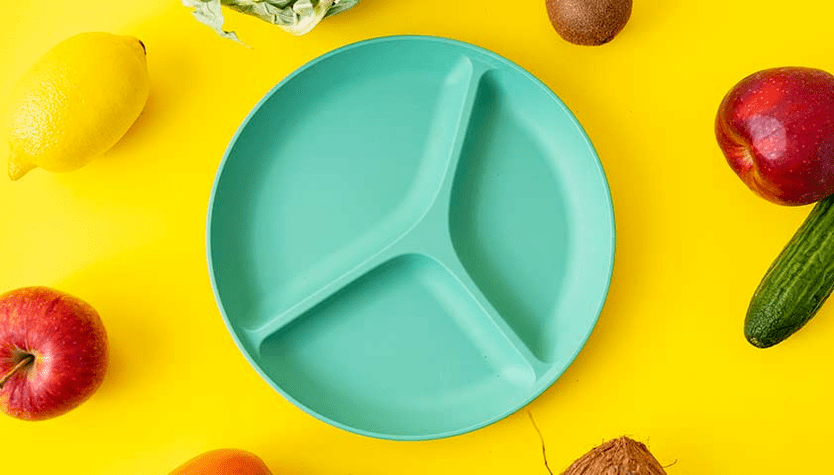
In stores you can buy dishes with dividers so that a healthy plate does not collect from the eye.
Often such plates are sold in the children's department.
Examples of diets for gestational diabetes using the Healthy Plate method
Breakfast:
- 1 apple,
- Handful of lettuce, ½ cucumber with a spoon of olive oil,
- 2 slices whole grain bread,
- 1 boiled egg,
- Curd without sugar.
dinner:
- A portion of fermented vegetables (sauerkraut, Korean carrots);
- a handful of brown rice;
- A piece of cooked white fish;
- A handful of nuts.
dinner:
- baked chicken breast,
- boiled green beans,
- Green salad with egg,
- A few pieces of cheese.
diet for diabetes in children
Children often have type 1 diabetes, so they must monitor their blood sugar levels and take insulin injections throughout their lives.
Usually, a normal school or daycare meal plan is the same as for people with diabetes. In the dining room they can eat everything except products containing pure sugar: for example, it is better to replace compote with unsweetened tea or water. Is.
Depending on what the child eats, he or his parents determine the necessary dose of insulin for administration. As a rule, the menu in the canteen is prepared a week in advance, so you can find out in advanceWhat will the child eat?
Another important condition is to ensure that the child has breakfast several times a day. This will help to avoid a sharp drop in blood glucose - hypoglycemia, which can cause him to faint.

Precursors of hypoglycemia – pale skin, excessive sweating, trembling hands, weakness
A mild attack of hypoglycemia can be quickly relieved by drinking sweet juice, eating a few lumps of sugar, or taking a glucose tablet. The child or parent should always have all this at hand: in a briefcase or bag.
In addition, it is important to explain to the teacher or caregiver that the child should always receive breakfast. Preferably at the same time. And before the physical education lesson, he definitely needs to measure his blood sugar and eat something with carbohydrates. This will help to avoid an attack of hypoglycemia because exercise makes the body burn glucose faster.
Sweet recipes for people with diabetes
People with diabetes often crave forbidden sweets, making it difficult for them to stick to a healthy diet. However, there are many sweets that contain large amounts of protein and fiber and do not spike blood sugar.
The carbohydrate content in all the recipes given does not exceed 15 grams or 1 bread unit. Stevia can be replaced with any common sugar substitute.
Panna cotta

One serving of the sweets contains 335 kcal, 2 g protein, 4 g carbohydrate, 4 g total sugar and 0 g added sugar.
Cooking Time: 15 minutes.
The dessert should be prepared in advance as it will take time to harden after cooking (at least 3 hours).
Material:
- 1. 5 tbsp. l dry gelatin
- 60 ml cold water
- 60 ml hot water
- 2 cups heavy cream (more than 30%)
- 2 spoons. vanillin
- Stevia as per taste (about 4 grams powder)
- a pinch of salt
Preparation:
- Pour the gelatin into a bowl of cold water and leave for a few minutes. Add hot water and stir well until the gelatin is completely dissolved.
- Add all other ingredients and stir until smooth.
- Pour the mixture into glasses and refrigerate for at least 3 hours.
Ready panna cotta can be garnished with fresh berries.
Chocolate Peanut Butter Fudge

One serving of sweets contains 76 kcal, 7 g fat, 3 g protein, 3 g carbohydrate, 1 g total sugar and 0 g added sugar.
Cooking Time: 10 minutes.
Material:
- 200 grams dark chocolate (2 standard bars)
- 200 grams unsweetened peanut butter
- 4 spoons. stevia powder
- ½ tsp. vanillin
- a pinch of salt
Preparation:
- Melt the chocolate in the microwave or double boiler.
- Mix all other ingredients with melted chocolate.
- Pour the mixture into a silicone baking dish. Cool to room temperature. Cut into pieces before serving.
Mousse Pumpkin Cheesecake

One serving of the dessert contains 136 kcal, 8 grams of protein, 13 grams of carbohydrates, 2 grams of fiber, 8 grams of total sugars and 5 grams of added sugars.
Cooking Time: 30 minutes.
Material:
- 150 grams pumpkin puree
- 150 g low-fat cottage cheese or ricotta
- 1. 5 tbsp. lhoney or maple syrup
- ½ tsp. cinnamon
- ½ tsp. vanillin
- a pinch of salt
- 50 grams Greek yogurt
- almond pieces for decoration
Preparation:
- Mix pumpkin puree, cheese, honey, cinnamon, vanilla and salt until smooth.
- Cover the cup with the resulting mixture with a lid or cling film and refrigerate for 30 minutes.
- Before serving, divide the mixture among glasses, garnish with curd and almond petals.
Apple Cinnamon Popcorn

One serving of sweets contains 154 kcal, 9 g fat, 2 g protein, 15 g carbohydrate, 3 g fiber, 5 g total sugar and 0 g added sugar.
Cooking Time: 10 minutes.
Material:
- 1 tsp olive oil
- 2 tbsp. dried popcorn kernels
- ¾ tsp. cinnamon
- 100 grams dried apples
Preparation:
- Heat oil in a small pan on medium flame.
- Add 1-2 popcorn kernels to the pan. Once they pop, you can take out the remaining popcorn.
- Cover the pan with a lid and wait until all the grains open. Shake the pan occasionally.carefully!Do not open the lid until the popcorn has cooled as the hot oil or hot kernels may burn your skin.
- Sprinkle cinnamon and apple pieces on finished popcorn.
Gogol-Mogol

One serving of the dessert contains 155 kcal, 9 g fat, 6 g protein, 6 g carbohydrate, 6 g total sugar and 0 g added sugar.
Cooking Time: 15 minutes.
Material:
- 6 medium eggs
- 5. 5 cups whole milk
- 0. 5 cups heavy cream (more than 30%)
- Stevia as per taste (about 4 grams powder)
- a pinch of cinnamon and nutmeg
Preparation:
- Add all the ingredients except nutmeg to a blender and blend until smooth.
- Pour the mixture into glasses and sprinkle with nutmeg.
Finished egg shells can be decorated with a cinnamon stick.

































